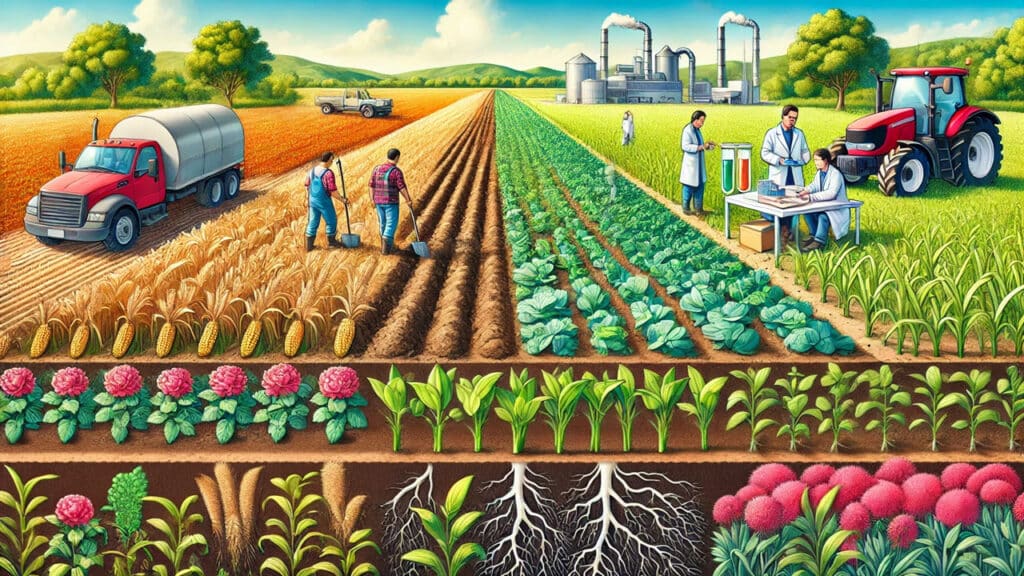by Tom Clynes, Environmental Defense Fund
The following blog post is an article written for the Environmental Defense Fund by Tom Clynes that was published on May 31, 2024. To read the original publication, click here.

The ground under our feet holds more carbon than the Earth’s atmosphere and all its plants combined. And since almost half the world’s habitable land is devoted to agriculture, efforts to encourage farmers to trap and hold carbon in their soil are picking up speed. More and more farmers today are adopting techniques such as reduced tilling and cover cropping to improve the health of their soils. In addition to reducing fossil fuel and water use, these soil management techniques also hold promise for storing carbon. But soil has many secrets that scientists are just beginning to unravel. “We have to approach this with humility, because there’s a lot we don’t know,” says Jocelyn Lavallee, a soil carbon expert at Environmental Defense Fund. As interest and investment in carbon soil management grows, Lavallee and a team of EDF scientists are digging into the mysteries of dirt.
High-stakes science
Nearly all scientists agree that under certain conditions, soils can capture carbon dioxide from the air and keep it locked way. But less is known about the intricate biogeochemical processes that acquire carbon or release it when disturbances, such as plowing, break up the soil’s structure. Lavallee decided to pursue a graduate degree in soil research because of its implications for the climate. “Soil is a massive store of carbon, and it could go one way or the other,” she says. “It could be a huge source, or it could be a huge sink. It affects so much of the Earth’s future.
On U.S. farms, soil management techniques like cover cropping (planting crops that cover and enrich the soil) and reduced tilling (leaving the soil as undisturbed as possible) are on the rise. About 11% of farms plant cover crops and about 40% use minimal or no tilling, according to a recent USDA survey. By improving soil health, these techniques help farmers build resilience to extreme weather, such as intense droughts and flooding. They can also reduce soil erosion and nutrient loss and increase biodiversity. “These benefits will become more and more important to help farmers cope with the effects of a changing climate,” says Emily Oldfield, an agricultural soil carbon scientist at EDF.
Hands in the dirt
Oldfield worked on a small vegetable farm after college. “The farmer told me, ‘Sure, I grow vegetables. But I’m really a soil farmer, because it’s all about the soil.’ I pursued a PhD to understand more about this,” she says. “Soil represents this nexus between the physical, chemical, and biological – the many complex interactions that combine to support food production.” Oldfield and Lavallee are re-examining the models that carbon credits and other incentives rely on to estimate how much carbon is entering and staying in the soil. “We don’t really know if they represent what’s actually happening to carbon in the ground when farmers adopt certain practices,” says Oldfield. The reliance on models stems from an assumption: Because soil carbon content can vary vastly over a single field, it wouldn’t be economically or logistically feasible to collect and analyze enough samples to directly measure how farmer’s efforts to improve soil health affect carbon storage across large tracts of farmland. “We think that you can and should measure the impact of those practices,” says Oldfield.
EDF teamed up with researchers from Yale University, General Mills and Ecosystem Services Market Consortium to run a test. Using a set of soil carbon samples collected by General Mills on 45 farm fields is Kansas, they found that it was feasible to gauge carbon buildup over a large area by taking samples from a smaller subset of fields. “The study suggests that we can use direct measurements to establish reliable estimates of soil carbon,” says Oldfield. “Having these estimates will instill confidence in the climate impacts of these practices.” In some case, models might still be useful; EDF is leading work to understand where and how they can best fit in. The researchers hope their work can help inform the federally funded Soil Carbon Monitoring Network, a national effort to sample, measure, and monitor the impacts of conservation practices on soil carbon. It can also guide investments by companies trying to understand the climate benefits of various agricultural techniques. “It’s exciting to think that we have the chance to understand these very complex processes within the soil,” says Lavallee, “and the ways that we can use them to carry out climate strategies that work.”
